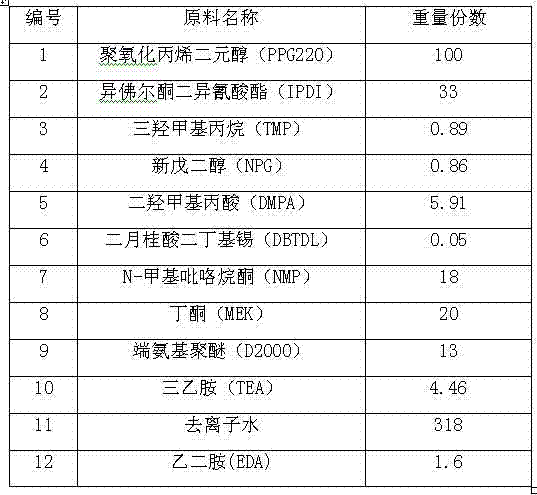Waterborne polyurethane binder and preparation method thereof
A technology of water-based polyurethane and linking materials, which can be used in inks, household utensils, applications, etc., and can solve problems such as gaps
- Summary
- Abstract
- Description
- Claims
- Application Information
AI Technical Summary
Problems solved by technology
Method used
Image
Examples
Embodiment 1
[0025] Before the preparation, the polymer polyol and the amino-terminated polyether are vacuum dehydrated. In a glass flask equipped with a thermometer, a stirrer and a reflux condenser, add a mixture of diisocyanate, polymer polyol, triol and diol, and at the same time add a hydrophilic chain extender, a co-solvent and a catalyst, under nitrogen protection at 80°C for 3 hours; then add amino-terminated polyether to extend the chain, and heat at 75°C for 2.5 hours; after cooling down to 40°C, add a neutralizing agent to form a salt, and neutralize for 6 minutes; add 25°C at room temperature Deionized water, disperse under high-speed stirring for 10 minutes; add a small molecule chain extender and react for 1 hour, and then the water-based polyurethane binder can be obtained.
[0026] The specific ratio is as follows:
[0027]
Embodiment 2
[0029] Before the preparation, the polymer polyol and the amino-terminated polyether are vacuum dehydrated. In a glass flask equipped with a thermometer, a stirrer and a reflux condenser, add a mixture of diisocyanate, polymer polyol, triol and diol, and at the same time add a hydrophilic chain extender, a cosolvent and a catalyst, under nitrogen protection at 85°C for 2.5 hours; then add amino-terminated polyether to extend the chain, and heat at 75°C for 2.5 hours; after cooling down to 40°C, add neutralizing agent to form a salt, and neutralize for 6 minutes; add 25°C at room temperature Deionized water, disperse under high-speed stirring for 10 minutes; add a small molecule chain extender and react for 1 hour, and then the water-based polyurethane binder can be obtained.
[0030] The specific ratio is as follows:
[0031]
Embodiment 3
[0033] Before the preparation, the polymer polyol and the amino-terminated polyether are vacuum dehydrated. In a glass flask equipped with a thermometer, a stirrer and a reflux condenser, add diisocyanate, a mixture of polymer polyols, triols and diols, and at the same time add hydrophilic chain extenders, co-solvents and catalysts, under nitrogen protection at 80°C for 3 hours; then add amino-terminated polyether to extend the chain, and heat at 78°C for 2 hours; after cooling down to 40°C, add neutralizing agent to form a salt, and neutralize for 6 minutes; add 25°C at room temperature Deionized water, disperse under high-speed stirring for 10 minutes; add a small molecule chain extender and react for 1 hour, and then the water-based polyurethane binder can be obtained.
[0034] The specific ratio is as follows:
[0035]
PUM
 Login to View More
Login to View More Abstract
Description
Claims
Application Information
 Login to View More
Login to View More - R&D
- Intellectual Property
- Life Sciences
- Materials
- Tech Scout
- Unparalleled Data Quality
- Higher Quality Content
- 60% Fewer Hallucinations
Browse by: Latest US Patents, China's latest patents, Technical Efficacy Thesaurus, Application Domain, Technology Topic, Popular Technical Reports.
© 2025 PatSnap. All rights reserved.Legal|Privacy policy|Modern Slavery Act Transparency Statement|Sitemap|About US| Contact US: help@patsnap.com



